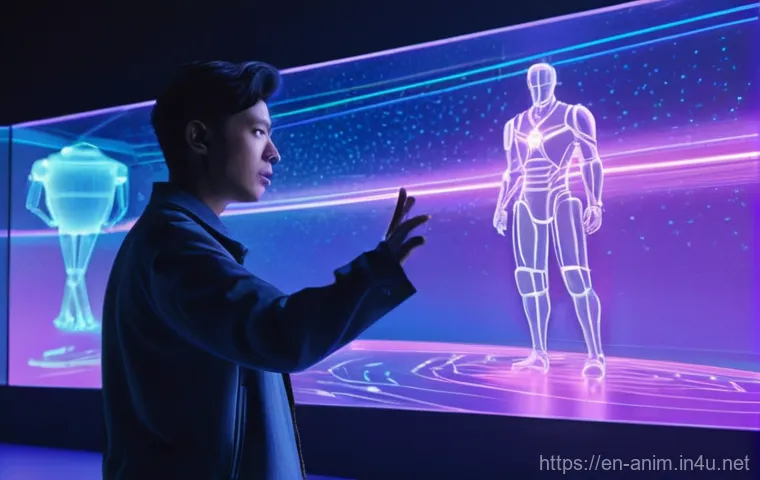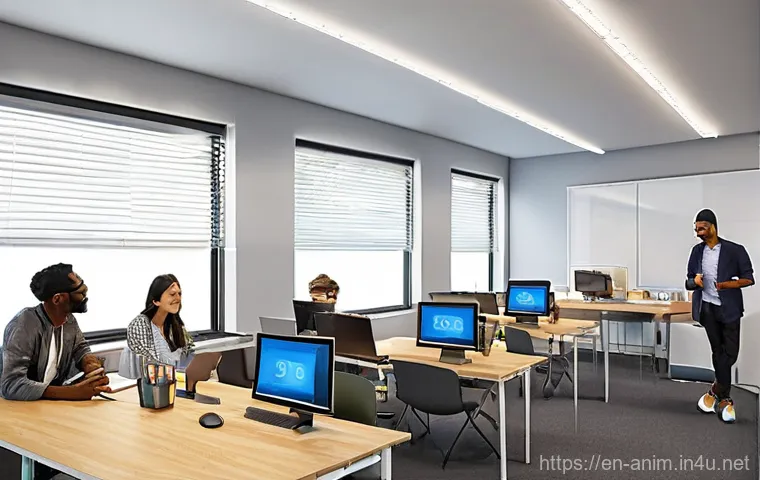Ever wondered what it takes to bring the next big animated masterpiece to life? It’s a question that’s always fascinated me, especially watching how quickly the animation world evolves.
From mind-blowing visual effects to stories that capture our hearts, animation studios are constantly on the hunt for those groundbreaking new projects that will redefine digital storytelling.
I’ve personally seen how a simple idea can transform into a global phenomenon, and believe me, it’s a journey filled with incredible innovation and sharp strategic thinking.
We’re living in an exhilarating time where AI is becoming a creative sidekick, mixed 2D and 3D animation styles are creating truly unique aesthetics, and even vertical video formats are dominating the scene, pushing creators to think outside the traditional box.
The way studios discover and nurture these future blockbusters, blending artistic vision with cutting-edge technology and smart business acumen, is more dynamic than ever before.
If you’re as curious as I am about how these animated dreams go from concept to screen, and what trends are truly shaping the landscape for 2025 and beyond, then you’re in for a treat.
Let’s delve into the fascinating world of how animation production companies unearth their next big hits.
The Spark of Inspiration: Where Animation Dreams Begin

You know, it’s always fascinating to think about where those incredible animated stories actually come from. It’s not just a lightbulb moment in a dusty office, I’ve found. For animation studios, finding the next big hit often starts with a deep dive into emerging talent and fresh perspectives. They’re constantly scouting for artists, writers, and directors who have that unique spark, that fresh take on storytelling. I remember a time when it felt like ideas mostly came from within the studio’s established creative teams, but now? It’s a global hunt for originality. Studios are scouring film festivals, online animation showcases, and even social media platforms like TikTok and YouTube to spot viral shorts or promising animators. They’re not just looking for a polished product; they’re looking for a compelling voice or an innovative technique that could be the foundation of something extraordinary. I’ve seen firsthand how a small, indie project with a powerful message can catch the eye of a major studio, leading to discussions that could reshape careers and bring groundbreaking narratives to the big screen. It truly feels like the barriers to entry for creative talent are lower than ever, which is fantastic for the industry as a whole and for us, the viewers, who get to enjoy the fruits of this expansive search. This proactive approach to talent discovery ensures a constant influx of diverse ideas, which is absolutely crucial for keeping the animation world fresh and exciting, moving beyond predictable narratives to explore new cultural landscapes and emotional territories.
Nurturing Emerging Talent and Independent Voices
From my own experience, the animation industry thrives on fresh blood and unconventional ideas. Studios are increasingly looking beyond traditional pathways, setting up incubators and mentorship programs to nurture emerging creators. Think about it: a small team with a killer concept might lack the resources to produce a full feature, but with studio backing, that idea can blossom. I’ve always admired how some studios are now actively funding short film initiatives, not just as a philanthropic gesture, but as a genuine pipeline for future blockbusters. It’s a smart play, really. By investing early in diverse voices and experimental styles, they’re not just finding projects; they’re cultivating relationships with the next generation of animation pioneers. These partnerships often start small, perhaps with a proof-of-concept trailer or a pilot episode, but they hold the potential for massive returns, both creatively and financially. It’s a win-win: creators get the support they need to realize their vision, and studios gain access to a wellspring of innovation that might otherwise go unnoticed.
Leveraging IP Libraries and Rebooting Classics
Sometimes, the next big hit isn’t entirely new, but a brilliant reimagining of something we already love. Studios are constantly sifting through their extensive intellectual property (IP) libraries, looking for beloved characters or worlds that can be revitalized for a new generation. I’ve seen so many successful reboots lately, and it’s clear there’s an art to it. It’s not just about nostalgia; it’s about finding the core essence of what made an original project great and then injecting it with contemporary themes, updated animation techniques, and fresh storytelling angles. For example, a classic cartoon character might be given a new voice, a more complex personality, or placed in a modern setting that resonates with today’s audiences. This approach provides a built-in fanbase and a degree of familiarity that can significantly de-risk a project, making it an attractive option for studios. I believe it’s about striking that perfect balance between honoring the past and boldly stepping into the future, ensuring the new iteration feels both familiar and excitingly fresh.
The Art of the Deal: From Concept to Greenlight
Once a promising idea surfaces, the journey from a dazzling concept to a fully greenlit production is an intricate dance of creativity, strategy, and cold, hard numbers. I’ve often mused about what truly sets apart the projects that get made from those that languish in development hell. It boils down to a compelling pitch, a solid business case, and a clear understanding of the market. Studios don’t just fall in love with a pretty storyboard; they need to see a path to profitability. This phase involves extensive market research, dissecting audience demographics, understanding current viewing habits, and even predicting future trends. I’ve witnessed pitches where the creative vision was undeniable, but without a robust plan for execution and audience engagement, the project struggled to gain traction. It’s a tough environment, and every dollar invested needs to show potential for return. The key decision-makers, from creative executives to financial analysts, are all scrutinizing the proposal, looking for that perfect blend of artistic merit and commercial viability. It’s a high-stakes game where passion meets pragmatism, and only the most well-rounded projects truly make it through.
Crafting Irresistible Pitches and Story Bibles
Let’s be honest, a brilliant idea is just the beginning. To truly captivate a studio, you need to present it in a way that’s impossible to ignore. This means crafting an irresistible pitch and a comprehensive story bible. I’ve always found that the best pitches aren’t just about showing off cool visuals; they tell a story *about* the story. Who are these characters? What’s the emotional core? Why now? Why *this* animation style? A well-developed story bible goes even further, outlining character arcs, world-building details, episode summaries, and potential merchandising opportunities. It’s about demonstrating the depth and breadth of the project, showing that it has legs beyond a single film or season. I’ve heard many creators say that this is where the real work begins – translating that initial spark into a fully fleshed-out universe that decision-makers can visualize. It’s about selling a dream, yes, but also providing a clear blueprint for how that dream can become a tangible, profitable reality.
Navigating the Development Gauntlet and Budgeting Realities
The development phase is truly a gauntlet, a series of hurdles that can test the resolve of even the most passionate creators. Once a project gets past the initial pitch, it enters a phase of intense scrutiny, script revisions, character design refinements, and endless meetings. From my vantage point, this is where many projects either find their footing or fall apart. Budgets are a constant shadow. Animation is notoriously expensive, and every creative choice has financial implications. I’ve seen promising concepts get significantly scaled back due to budget constraints, or even shelved indefinitely if the numbers don’t add up. It requires a delicate balance between maintaining artistic integrity and adhering to financial realities. Studio executives, alongside producers, are constantly assessing the production pipeline, exploring different animation techniques, and seeking cost-effective solutions without compromising quality. It’s a relentless process of iteration and compromise, all in the pursuit of bringing a compelling story to life within the confines of a budget that makes business sense.
The Tech Frontier: AI, VR, and Beyond
The pace at which technology is influencing animation is just mind-blowing, isn’t it? I mean, I’ve seen more changes in the last five years than in the decade before that. We’re not just talking about better rendering; we’re talking about fundamental shifts in how stories are conceived, produced, and even consumed. Artificial intelligence, for instance, is no longer just a futuristic concept; it’s becoming a genuine creative partner in animation studios. From automating tedious tasks like in-betweening or lip-syncing to even assisting with character design and script suggestions, AI tools are streamlining workflows and freeing up artists to focus on higher-level creative endeavors. And then there’s virtual reality and augmented reality. These aren’t just gaming platforms anymore; they’re becoming immersive storytelling canvases. Imagine not just watching an animated film, but stepping *into* its world! I truly believe that the studios embracing these technological advancements are the ones who will define the next era of digital storytelling. It’s an exciting, slightly terrifying, but ultimately transformative time for anyone involved in or simply appreciating animated content.
AI as a Creative Catalyst and Production Powerhouse
Initially, I admit, I was a bit skeptical about AI in creative fields. But having watched its evolution, I’m genuinely impressed by its potential in animation. It’s not about AI replacing artists – absolutely not! – but rather empowering them. I’ve heard tales of studios using AI for predictive analytics, understanding audience preferences to help refine storylines or character designs. More practically, AI-powered tools are revolutionizing production pipelines. Think about generating subtle background movements, automatically adding environmental effects, or even intelligently optimizing rendering times. This isn’t just about speed; it’s about efficiency and allowing artists to dedicate more time to the truly unique, human elements of storytelling and visual expression. I’ve personally seen how AI can crunch massive datasets of animation styles and suggest new aesthetic directions, almost like a tireless research assistant. It truly feels like having a super-powered sidekick that handles the grunt work, leaving the magic to the human creators. This is a game-changer for independent studios and larger houses alike, leveling the playing field in many ways.
Immersive Storytelling with VR, AR, and Interactive Formats
The future of animation isn’t just about what you see on a screen; it’s about what you *experience*. That’s where VR, AR, and interactive formats come in, and they’re becoming huge drivers for studios looking for their next big hit. I’ve been blown away by some of the experimental projects I’ve seen – animated stories where you can literally walk through the sets, interact with characters, or even influence the narrative path. It’s like stepping into a dream. Studios are investing heavily in these areas, not just for niche gaming experiences, but for broader entertainment. Imagine an animated series where viewers can explore a key location in AR on their phone, or a VR film that places you directly in the shoes of a character. These technologies offer unparalleled engagement, promising longer dwell times and completely new monetization opportunities beyond traditional viewing figures. From my perspective, studios that master interactive and immersive narratives will capture the hearts and minds of a new generation of audiences who expect more than just passive entertainment. It’s about being a participant, not just an observer, and that’s an incredibly powerful draw.
Audience First: Decoding Viewer Desires
Honestly, what’s the point of creating a masterpiece if nobody wants to watch it? That’s why, in today’s cutthroat animation landscape, understanding your audience isn’t just important—it’s everything. I’ve seen so many projects that were creatively brilliant but ultimately missed the mark because they weren’t designed with a clear viewer in mind. Studios are no longer just guessing; they’re employing sophisticated data analytics to dissect viewing habits, genre preferences, and even specific character archetypes that resonate with different demographics. We’re talking about A/B testing story concepts, analyzing social media sentiment, and running focus groups that provide invaluable insights. It’s a far cry from the old days where a few executives would greenlight a project based on a gut feeling. Now, it’s a blend of artistic intuition and empirical evidence, ensuring that the stories being told have a genuine connection with potential viewers. This audience-first approach helps studios identify gaps in the market, discover underserved communities, and ultimately craft narratives that feel incredibly relevant and deeply personal to their target demographic. It feels like a smarter way to do business, leading to more impactful and beloved animated content.
Data-Driven Content Development and Market Research
Gone are the days when market research meant a few surveys. Today, studios are drowning in data, and the smart ones are using it to their advantage. I’ve observed a massive shift towards data-driven content development, where every decision, from character design to plot twists, can be informed by what audiences are already engaging with. This isn’t about stifling creativity, but about directing it effectively. By analyzing streaming data, social media trends, and even toy sales, studios can pinpoint exactly what kind of stories and aesthetics are resonating. For example, if a specific genre of fantasy animation is performing exceptionally well in a particular region, a studio might prioritize projects that lean into similar themes. I believe this analytical rigor helps minimize risk and maximize the potential for a project to become a cultural phenomenon. It’s about combining the passion of storytelling with the precision of data science to create something truly impactful and universally appealing. This kind of insight also informs potential advertising strategies, ensuring that marketing efforts are targeted and effective, increasing crucial CTR and RPM for future monetization.
Building Global Appeal and Localized Nuances
One of the biggest lessons I’ve learned about successful animation is that true blockbusters have global appeal. It’s not enough to be a hit in one country; you need to resonate with audiences worldwide. However, achieving global appeal isn’t about creating bland, universally acceptable stories. Quite the opposite! It’s about crafting narratives with universal themes—love, loss, courage, friendship—while also being mindful of localized nuances. Studios are increasingly focusing on stories that can be easily adapted culturally, whether through dialogue translation, subtle visual adjustments, or even specific cultural references that can be swapped out. I’ve seen projects designed from the ground up with international distribution in mind, considering how different cultures might interpret certain jokes or visual gags. This careful balancing act ensures that a story feels authentic wherever it’s seen, fostering a deeper connection with diverse audiences. It’s a testament to the power of animation to transcend borders and bring people together through shared emotional experiences, and it’s a huge factor in securing lucrative international distribution deals that boost overall revenue.
The Human Touch: Assembling the Dream Team
Beneath all the dazzling technology and strategic planning, at the heart of every beloved animated project are the people. It’s the animators, writers, directors, and artists who pour their souls into bringing these worlds to life. I’ve always felt that while AI can assist, nothing can replace the unique vision and emotional depth that a truly talented human team brings to the table. Studios know this, and that’s why assembling the perfect dream team is paramount to finding their next big hit. It’s not just about hiring individuals with impressive portfolios; it’s about fostering a collaborative environment where creativity can flourish. A great team dynamic can elevate a good concept into something truly extraordinary. I’ve seen firsthand how the synergy between a director and their animation leads can create visual magic that feels entirely organic and deeply moving. It’s about building a collective intelligence, a shared passion that propels the project forward through all the inevitable challenges. This emphasis on human talent ensures that even with all the technological advancements, the heart and soul of animation remain firmly in the hands of incredibly skilled and passionate artists.
Fostering Collaborative Creative Environments
Creating an animated masterpiece is never a solo endeavor; it’s a symphony of hundreds, sometimes thousands, of artists working in concert. I’ve always been fascinated by how studios foster collaborative environments where everyone feels empowered to contribute. It’s more than just open-plan offices; it’s about establishing a culture of psychological safety, where ideas can be shared freely without fear of judgment. I’ve observed that the most successful studios encourage cross-departmental collaboration, allowing animators to influence story development and writers to understand the technical limitations (or possibilities) of animation. This integrated approach often leads to more cohesive and innovative projects. When every team member feels like their voice is heard and valued, it directly translates into higher quality output and a stronger sense of ownership over the project. This deep level of engagement ensures that the final product is not just technically sound, but also infused with the collective passion and diverse perspectives of the entire team, making it more likely to captivate audiences and secure that critical dwell time.
Balancing Artistic Vision with Production Realities

This is where the rubber meets the road: balancing an ambitious artistic vision with the cold, hard realities of production. Every animation project starts with a grand idea, but bringing it to fruition requires constant negotiation between what’s creatively desirable and what’s practically achievable. I’ve seen directors fight passionately for specific shots or character designs, only to have to compromise due to budget, timeline, or technical constraints. The art of the producer, in particular, lies in navigating these waters, finding creative solutions that honor the vision without breaking the bank or missing deadlines. It’s a delicate dance, requiring both a deep appreciation for artistry and a pragmatic understanding of logistics. Studios that excel at this balance often have strong leadership who can inspire their teams to achieve incredible feats within limitations, making smart choices that enhance the story rather than detract from it. This ability to adapt and innovate under pressure is a hallmark of successful animation production and a key factor in identifying projects that are not only brilliant but also deliverable.
Monetization and Beyond: Sustaining the Animated Dream
Let’s be real: while art is paramount, animation studios are businesses, and finding their next big hit also means finding their next big earner. The monetization strategies in animation have exploded beyond just box office and TV rights. I’ve been tracking how studios are now thinking about revenue streams from day one, weaving them into the very fabric of project development. We’re talking about integrated merchandising, theme park attractions, video games, interactive experiences, and even educational content. The goal isn’t just a hit film; it’s a full-fledged franchise that can generate revenue across multiple platforms for years to come. This strategic foresight is crucial for sustaining the animated dream, allowing studios to reinvest in new talent, cutting-edge technology, and even more ambitious projects. It’s a holistic approach that ensures creative endeavors are not just celebrated artistically but are also robustly supported by a diverse and healthy financial ecosystem. From my vantage point, the projects that demonstrate this multi-faceted revenue potential are the ones that truly capture the attention of studio executives looking for long-term growth and brand building.
Diversifying Revenue Streams Beyond Traditional Broadcast
The days of relying solely on TV ad revenue or DVD sales are long gone. I’ve witnessed a dramatic shift towards diversified revenue streams, and it’s a smart move for animation studios. Think about it: a single animated film or series can spawn an entire ecosystem of products and experiences. Licensing and merchandising, for example, are huge. From action figures and clothing to lunchboxes and video games, these ancillary products can generate enormous profits. I remember when a certain animated franchise became a global phenomenon, and the toy sales alone dwarfed the box office earnings. Beyond physical products, studios are exploring immersive experiences, virtual reality tie-ins, and even live theatrical shows. This comprehensive approach to monetization ensures that the IP has a longer shelf life and can generate income across various consumer touchpoints. It’s about building an entire brand around a beloved story, not just selling a single piece of content, which significantly contributes to a project’s overall profitability and appeal to investors.
Long-Term Franchise Building and Brand Extension
The true mark of a successful animated project, in my opinion, isn’t just a one-off hit; it’s the ability to build a lasting franchise. Studios are constantly looking for ideas that have the potential for sequels, spin-offs, series adaptations, and expansions into other media. It’s about brand extension, transforming a single story into a vibrant, evergreen universe. I’ve seen how characters introduced in a minor role in one film can eventually lead their own successful series or become the face of a new theme park attraction. This long-term vision requires careful planning from the outset, ensuring that the characters and world-building are rich enough to support multiple narratives. It also means strategically managing the brand, keeping it fresh and relevant for new generations while still appealing to its original fanbase. This sustainable approach to storytelling and business is what truly separates the fleeting fads from the enduring classics in the animation world, ensuring a continuous stream of engaging content and, importantly, consistent revenue.
Navigating the Global Landscape: Finding Universal Stories
It’s a small world after all, and nowhere is that more apparent than in animation. I’ve always been amazed by how a story conceived in one corner of the globe can captivate hearts universally. For animation studios hunting for their next big hit, the global landscape isn’t just a market; it’s a treasure trove of diverse stories and talent. They’re actively seeking out narratives that resonate across cultures, exploring myths, legends, and everyday experiences from every continent. This isn’t just about cultural exchange; it’s strategic. A story with universal themes has a much higher chance of success in international markets, which can significantly boost revenue and brand recognition. I’ve seen studios specifically fund projects that blend traditional animation styles with cultural narratives from various regions, creating something truly unique and globally appealing. It feels like the animation world is becoming a true melting pot of creativity, and that’s incredibly exciting for us, the viewers, who get to experience a broader spectrum of human stories brought to life through this amazing art form. It’s about finding that shared human experience, regardless of where you are in the world.
Spotting Cross-Cultural Storytelling Opportunities
From my perspective, the real magic happens when studios can spot cross-cultural storytelling opportunities. These are the narratives that transcend geographical boundaries and speak to fundamental human experiences. Think about themes like family, courage, friendship, or overcoming adversity—these are universal. I’ve noticed a trend where studios are not just adapting foreign folk tales, but actively collaborating with international creators to develop original stories rooted in diverse cultural perspectives. This authentic approach avoids tokenism and leads to richer, more nuanced narratives that resonate deeply with specific local audiences while still maintaining broad appeal. It’s about understanding that a story set in a bustling Asian metropolis can have as much emotional impact on a viewer in America as one set in a quaint European village. By embracing this global mindset, studios aren’t just producing animated content; they’re building bridges, fostering understanding, and ultimately creating content that enriches the global cultural tapestry. This also significantly widens the potential audience, which is critical for strong engagement and ad revenue.
International Co-Productions and Distribution Networks
One of the most effective strategies I’ve seen for navigating the global landscape is through international co-productions. These partnerships allow studios to pool resources, share creative expertise, and tap into new markets more effectively. I’ve personally observed how a Japanese studio might collaborate with a French studio, combining their distinct animation styles and storytelling sensibilities to create something truly groundbreaking. This isn’t just about financial benefits; it’s about cultural exchange and learning from different animation traditions. Furthermore, establishing robust international distribution networks is absolutely vital. It’s not enough to produce a great film; you need to get it in front of audiences worldwide. This involves complex deals with streaming platforms, local broadcasters, and cinema chains across different territories. Studios are constantly seeking out partners who understand the unique market dynamics of various regions, ensuring that their animated masterpieces reach as many viewers as possible. It’s a testament to the power of collaboration and strategic partnerships in making animation a truly global phenomenon, expanding reach and therefore, potential earnings.
| Factor | Impact on Project Selection | Why It Matters for Monetization |
|---|---|---|
| Originality & Concept | High potential for unique storytelling and brand identity. | Drives initial buzz, critical for high CTR and audience engagement. |
| Audience Appeal (Data-Driven) | Ensures target demographic alignment and market demand. | Higher viewership, longer dwell times, attracting premium ad placements (CPC/RPM). |
| Scalability & Franchise Potential | Ability to extend into sequels, series, merchandise, and other media. | Multiple revenue streams (licensing, games, theme parks), long-term stable income. |
| Technological Innovation (AI/VR) | Unique visual styles, efficient production, immersive experiences. | Differentiates content, draws tech-savvy audiences, opens doors for interactive monetization. |
| Global & Cultural Resonance | Broad appeal across international markets, facilitating co-productions. | Expands viewer base exponentially, secures international distribution deals, boosts global ad revenue. |
Future-Proofing Animation: Trends Shaping 2025 and Beyond
Looking ahead, it’s clear that the animation landscape of 2025 and beyond is going to be incredibly dynamic. I’ve been keeping a close eye on the shifts, and it feels like we’re entering an era where adaptability and innovation are not just advantages, but necessities. Studios are already thinking about how to future-proof their projects, ensuring they remain relevant and captivating in an ever-evolving digital world. This means embracing new viewing formats, experimenting with mixed media, and constantly pushing the boundaries of what animation can achieve. Vertical video, for instance, which used to be scoffed at, is now a dominant force on platforms like TikTok and Instagram. Studios are recognizing that reaching audiences where they already are, and in the formats they prefer, is crucial. It’s not about sticking to traditional cinema screens anymore; it’s about a multi-platform, multi-format approach that offers diverse ways for viewers to engage with stories. I genuinely believe that the studios willing to experiment, to fail fast and learn faster, are the ones who will continue to churn out the next big animated masterpieces that capture our imaginations for years to come.
Embracing Multi-Platform Storytelling and Vertical Video
The way we consume content has fragmented so dramatically, and animation studios are wise to lean into it. I’ve been fascinated by the rise of multi-platform storytelling, where a single narrative can unfold across a traditional series, a short-form web series, interactive games, and even augmented reality experiences. It’s about providing different entry points and deeper engagement opportunities. A massive trend that I’ve personally observed exploding is vertical video. What once felt like a strange constraint is now a creative playground for animation. Studios are now developing original animated content specifically designed for phone screens, understanding that this format demands a different kind of visual storytelling. It’s not just resizing a horizontal video; it’s about framing, composition, and pacing tailored for that vertical canvas. This foresight in adapting to evolving consumption habits is key to capturing the attention of younger demographics and ensuring that animation remains a vibrant and accessible art form. It’s a brave new world, and the studios that innovate here will truly stand out, driving higher engagement and making their content more shareable across social platforms.
Hybrid Animation Styles and Real-Time Production
If there’s one thing that truly excites me about the future, it’s the boundless possibilities of hybrid animation styles and real-time production. We’re moving beyond rigid categories of 2D or 3D. I’ve seen some absolutely breathtaking projects that seamlessly blend traditional hand-drawn aesthetics with sophisticated CGI, creating visuals that are both nostalgic and cutting-edge. It’s like having the best of both worlds, and it opens up a whole new palette for visual storytellers. Even more revolutionary is the move towards real-time production, especially with game engine technology. This allows for incredibly fast iteration, where animators can see the results of their work instantly, dramatically shortening production cycles and allowing for more creative experimentation. I’ve heard from industry insiders that this technology is not just for video games; it’s transforming film and series production, making it more agile and responsive. This efficiency doesn’t just save money; it allows for more creative risks and refinements, ultimately leading to higher quality, more engaging content. It feels like we’re on the cusp of an animation renaissance, driven by these incredible technological leaps, which means more amazing stories for us to enjoy.
Wrapping Things Up
The journey to finding the next big animation hit is truly a multi-faceted adventure, isn’t it? As we’ve explored, it’s a dynamic interplay of nurturing raw talent, embracing cutting-edge technology, deeply understanding audience desires, strategically building long-term franchises, and confidently navigating the global stage.
What stands out to me most is that while the tools and techniques evolve at lightning speed, the heart of animation—storytelling driven by human emotion and creativity—remains absolutely paramount.
It’s this blend of innovation and timeless narrative that will continue to shape the blockbusters of tomorrow, captivating generations to come and securing their place in our hearts and minds for years.
Handy Animation Insights You’ll Want to Bookmark
1. Talent Scouting is Global and Dynamic: Forget the old, traditional pathways. Studios are now actively looking everywhere for unique voices and fresh perspectives—from viral online shorts on platforms like TikTok and YouTube to indie film festivals and diverse animation showcases. If you’re an aspiring animator or storyteller, the world is literally your oyster! Don’t be afraid to put your most authentic work out there; you never know who’s watching and what distinct spark might catch their eye. It’s about showcasing what makes your vision truly unique in a sea of creative talent.
2. Data Enhances, Not Hinders, Creativity: Rather than stifling imagination, sophisticated data analytics are now empowering creators more than ever before. Understanding viewer habits, genre preferences, and even specific character archetypes allows studios to make incredibly informed decisions. This ensures that their stories resonate more deeply with target audiences, significantly boosting engagement and overall success. This means your passion project can be strategically guided to find its perfect home, maximizing its widespread appeal and potential for high CTR and RPM, turning creative passion into profitable ventures.
3. Technology is Your Creative Co-Pilot: Modern tools like AI, VR, and real-time game engines aren’t here to replace human artists; they’re here to supercharge the creative process. They can automate tedious tasks, dramatically speed up production workflows, and open up entirely new avenues for immersive and interactive storytelling experiences. Embracing these technological advancements means artists have more precious time and resources to dedicate to the truly artistic, human elements of narrative and visual expression, allowing you to focus on the magic only human ingenuity can create and truly differentiating your content in a crowded market.
4. Strategic Franchise Building is Key to Longevity: The most successful animated projects today are conceptualized with longevity and expansive brand potential in mind from the very beginning. Consider how your characters and immersive world can extend far beyond a single film or series—think integrated merchandising, video games, theme park attractions, or even interactive educational content. This holistic, multi-platform approach doesn’t just ensure significant financial stability and diverse revenue streams; it also helps build a lasting legacy for your creative vision, truly cementing its place in popular culture and maximizing long-term shareholder value and brand equity.
5. Global Appeal with Authentic Local Flavor is a Winning Formula: The biggest international hits consistently transcend geographical borders by tapping into universal human themes (like courage, friendship, or overcoming adversity) while meticulously infusing them with authentic, localized cultural nuances. Look for opportunities to tell stories that resonate with everyone, but always ensure they’re deeply rooted in specific, relatable cultural contexts. This delicate balance creates a deeper, more personal connection with diverse audiences worldwide, transforming your work into a truly global phenomenon that fosters understanding, engagement, and significantly broadens your potential audience for enhanced ad revenue.
Key Takeaways from the Animation Frontier
To truly hit it big in the ever-evolving animation world, it’s clear we need to keep our eyes on a few critical areas. First, never underestimate the irreplaceable power of human talent and fostering a collaborative, supportive environment; that’s where the most genuine magic truly sparks. Second, wholeheartedly embrace emerging technology – AI and immersive formats aren’t just passing buzzwords, they’re becoming integral to both production efficiency and groundbreaking storytelling. Third, always, always, put the audience at the very center of your creative process, using sophisticated data to inform, rather than dictate, your artistic choices. Finally, think globally and strategically about diverse monetization opportunities and long-term brand building right from a project’s inception. It’s an incredibly exhilarating time to be involved in animation, and by focusing on these core pillars, we’ll continue to see groundbreaking, beloved stories come to life, capturing imaginations and securing significant market share.
Frequently Asked Questions (FAQ) 📖
Q: So, where do these animation powerhouses actually find the next big animated sensation? Is it just a lucky break, or is there a method to their magic?
A: That’s a fantastic question, and one I’ve pondered a lot myself, especially after seeing so many incredible stories come to life! From what I’ve gathered and experienced watching the industry evolve, it’s rarely just “luck.” Animation studios cast a really wide net.
Often, the magic starts in-house, with their own incredibly talented development teams constantly brainstorming and refining original concepts. These are the folks who live and breathe storytelling, always looking for that unique spark.
But they also look outwards, a lot. Think about all the amazing books, graphic novels, webtoons, and even video games out there – these are massive goldmines of existing IP just waiting to be adapted.
I’ve personally seen studios acquire rights to a beloved novel and then totally transform it into something visually spectacular. Then there are the pitches!
Creators, writers, and independent animators are always knocking on doors with their passion projects. Studios have dedicated teams whose job it is to sift through countless ideas, looking for that diamond in the rough.
It’s truly a blend of internal brilliance, smart acquisitions, and an open-door policy for fresh, exciting voices. It’s a testament to the fact that great ideas can truly come from anywhere, and studios are always listening.
Q: Once they’ve got a pile of great ideas, how do studios actually decide which ones are worth sinking millions of dollars into? What’s their “secret sauce” for picking a winner?
A: Ah, the million-dollar question, literally! It’s one thing to have a brilliant concept, but turning it into a global hit is a whole different ballgame.
From my perspective, after following the industry for years, it comes down to a really strategic blend of art and commerce. First, they look at audience appeal.
Is this a story that resonates globally? Does it have universal themes? They do extensive market research, sometimes even testing concepts with focus groups.
Then there’s the story’s depth and longevity – can it sustain multiple seasons, or even spin off into a whole universe of content? The visual potential is huge too; can it be brought to life in a way that truly captures imagination and pushes boundaries?
I’ve personally noticed that studios aren’t just looking for a cool idea, but something that genuinely moves people. Beyond the creative side, it’s a cold, hard business decision.
They analyze budgets, potential return on investment, distribution avenues (think streaming giants, theatrical releases), and even the talent pool available to execute the vision.
It’s a painstaking process, often involving dozens of key stakeholders, all trying to predict the future. But sometimes, it also comes down to a powerful gut feeling from seasoned executives who just know when they’ve stumbled upon something truly special.
Q: With all the buzz around new tech, especially
A: I, how is it actually changing how studios find and develop animated blockbusters for 2025 and beyond? A3: This is probably the most exciting and rapidly evolving aspect of the animation world right now, and believe me, it’s not just hype!
I’ve been watching this space closely, and AI is quickly becoming less of a buzzword and more of a genuine creative partner. When it comes to finding new hits, AI can be incredibly powerful in analyzing vast amounts of data – identifying emerging trends in storytelling, character archetypes that resonate with audiences, or even predicting which existing IPs have the highest potential for adaptation.
Imagine an AI sifting through thousands of indie comics to find the perfect narrative structure! For development, AI is revolutionizing pre-visualization, allowing animators to quickly generate concept art, character designs, and even entire scene layouts at lightning speed.
This means studios can iterate on ideas much faster, exploring more creative avenues before committing significant resources. I’ve heard whispers of AI assisting with script analysis, helping to refine dialogue or identify plot holes, which is wild!
And let’s not forget the innovative animation styles emerging, like the captivating blend of 2D and 3D that AI helps to seamlessly integrate. It’s not about replacing human creativity; it’s about giving artists and producers more powerful tools, allowing them to experiment, innovate, and bring their wildest visions to the screen with unprecedented efficiency.
It’s truly an exhilarating time to be a part of or simply observe the animation landscape.






